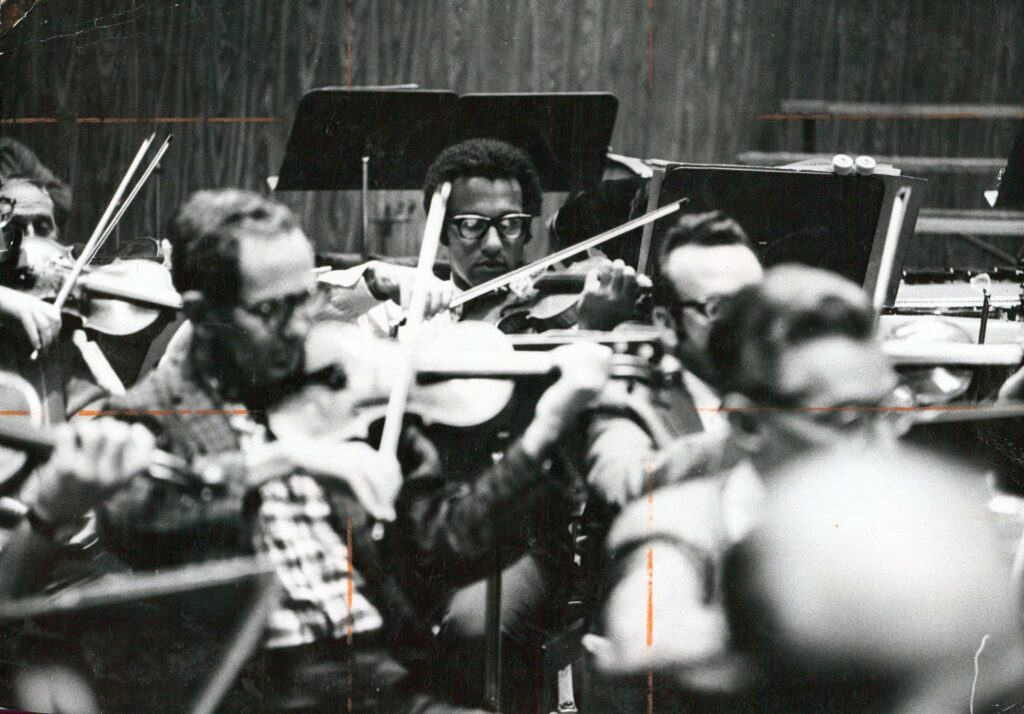
By Anthony Tommasini / New York Times
During the tumultuous summer of 1969, two Black musicians accused the New York Philharmonic of discrimination. Earl Madison, a cellist, and J. Arthur Davis, a bassist, said they had been rejected for positions because of their race.
The city’s Commission on Human Rights decided against the musicians, but found that aspects of the orchestra’s hiring system, especially regarding substitute and extra players, functioned as an old boys’ network and were discriminatory. The ruling helped prod American orchestras, finally, to try and deal with the biases that had kept them overwhelmingly white and male. The Philharmonic, and many other ensembles, began to hold auditions behind a screen, so that factors like race and gender wouldn’t influence strictly musical appraisals.
Blind auditions, as they became known, proved transformative. The percentage of women in orchestras, which hovered under 6 percent in 1970, grew. Today, women make up a third of the Boston Symphony Orchestra, and they are half the New York Philharmonic. Blind auditions changed the face of American orchestras.
But not enough.
American orchestras remain among the nation’s least racially diverse institutions, especially in regard to Black and Latino artists. In a 2014 study, only 1.8 percent of the players in top ensembles were Black; just 2.5 percent were Latino. At the time of the Philharmonic’s 1969 discrimination case, it had one Black player, the first it ever hired: Sanford Allen, a violinist. Today, in a city that is a quarter Black, just one out of 106 full-time players is Black: Anthony McGill, the principal clarinet.
The status quo is not working. If things are to change, ensembles must be able to take proactive steps to address the appalling racial imbalance that remains in their ranks. Blind auditions are no longer tenable.
This well-intentioned but restrictive practice has prevented substantive action when it comes to the most essential element of maintaining an orchestra: hiring musicians. Musicians’ unions, which have in many ways valiantly worked to protect their members in an economically tenuous industry, have long been tenacious defenders of blind auditions, asserting that they are the best way to ensure fairness.
But in sticking so stubbornly to the practice, unions may be hurting themselves, their orchestras and their art form. Hanging on to a system that has impeded diversity is particularly conspicuous at a moment when the country has been galvanized by revulsion to police brutality against Black Americans — and when orchestras, largely shuttered by the coronavirus pandemic, are brainstorming both how to be more relevant to their communities and how to redress racial inequities among their personnel when they re-emerge.
If the musicians onstage are going to better reflect the diversity of the communities they serve, the audition process has to be altered to take into fuller account artists’ backgrounds and experiences. Removing the screen is a crucial step.
Blind auditions are based on an appealing premise of pure meritocracy: An orchestra should be built from the very best players, period. But ask anyone in the field, and you’ll learn that over the past century of increasingly professionalized training, there has come to be remarkably little difference between players at the top tier. There is an athletic component to playing an instrument, and as with sprinters, gymnasts and tennis pros, the basic level of technical skill among American instrumentalists has steadily risen. A typical orchestral audition might end up attracting dozens of people who are essentially indistinguishable in their musicianship and technique.
It’s like an elite college facing a sea of applicants with straight A’s and perfect test scores. Such a school can move past those marks, embrace diversity as a social virtue and assemble a freshman class that advances other values along with academic achievement. For orchestras, the qualities of an ideal player might well include talent as an educator, interest in unusual repertoire or willingness to program innovative chamber events as well as pure musicianship. American orchestras should be able to foster these values, and a diverse complement of musicians, rather than passively waiting for representation to emerge from behind the audition screen.
Some leaders in the field I’ve spoken with over the years have argued that the problem starts earlier than auditions. They say racial diversity is missing in the so-called pipeline that leads from learning an instrument to summer programs to conservatories to graduate education to elite jobs. In this view, even that strong pool of equally talented hypothetical auditioners might have few, if any, Black or Latino players in it.
Yet Afa S. Dworkin, the president of the Sphinx Organization, which is dedicated to encouraging diversity in classical music by fostering young artists, argues that the pipeline is not the problem, and that talented musicians of color are out there and ready.
“As we speak,” she said in a recent online roundtable discussion among leading Black musicians, “about 96 Black and brown students who were competitively selected from hundreds who auditioned for Sphinx’s summer programs are going to go through intensive solo and chamber music training.”
She added that any of those young artists would soon be worthy of entrance to an elite conservatory and, in just a few years, ready for top-tier auditions.
Sphinx has been attempting to change the auditions landscape. Two years ago, alongside the New World Symphony, a prestigious — and notably diverse — training orchestra for post-college musicians, and the League of American Orchestras, a trade group, Sphinx began a program to train musicians for auditions by pairing them with mentors, giving them performance opportunities and awarding them stipends to travel to auditions. (The heavy costs associated with auditions disproportionately affect younger musicians of color; if you can’t afford to buy many flights and hotel rooms each year, it doesn’t matter how well you play.)
But orchestras must be a part of changing the landscape, too, by getting rid of blind auditions.
Change can be unnerving. Might the gains female players have made be reversed if the screen comes down? Might old habits of favoring the students of veteran players return? Orchestras will need to be transparent about their goals and procedures if they are to move forward with a new approach to auditions — one that takes race and gender into account, along with the full spectrum of a musician’s experience.
I put the question to Mr. McGill, the Philharmonic’s principal clarinet since 2014, who was more ambivalent about blind auditions than I am.
“I don’t know what the right answers are,” he said, adding that the screen has proved effective at eliminating the coziness that can creep into the auditions process when members of the jury have worked with the person playing.
Yet, he added, “representation matters more than people know.” He recalled how crucial it was to his early development as a clarinetist, growing up on the South Side of Chicago, to be part of the Chicago Teen Ensemble, a small group of young Black musicians who worked with a coach, made their own musical arrangements and toured the city giving concerts. It gave Mr. McGill, he said, a sense that classical music “is very normal,” the same sense his presence could give to a young Black person watching the Philharmonic.
“Is slow and steady change fast enough?” he asked. “The world has changed around us.”
When the Philharmonic plays, Mr. McGill stands out, not just for his magnificent playing but also as the kind of role model he looked to as a young artist. Yet, now more than ever, the spectacle of a lone Black musician on a huge, packed stage at Lincoln Center is unbearably depressing. Slow and steady change is no longer fast enough.

